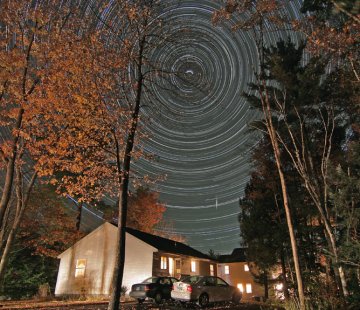 Autumn is here, and it's a wonderful time for stargazing. Find out what's up from Spaceweather PHONE.
Autumn is here, and it's a wonderful time for stargazing. Find out what's up from Spaceweather PHONE.
ORIONID METEOR SHOWER: This weekend, a mild but pretty flurry of meteors will shoot out of the constellation Orion. The source is Halley's Comet. Although the comet itself is far away, ancient clouds of dust from the comet are nearby, and Earth is about to run through them. The best time to look is Saturday morning, Oct. 21st, just before local dawn: sky map.
CORONAL HOLE: There's a gaping black hole on the sun today, shown here in an X-ray image from NOAA's GOES-13 satellite:

The technical term is "coronal hole." It's a place in the sun's atmosphere where magnetic fields open up and allow solar wind to escape. A stream of solar wind flowing from this hole should reach Earth on Oct. 20th or 21st, possibly sparking a geomagnetic storm. Sky watchers, be alert for auroras!
STAR TRAILS: Warning. Staring at this picture may make you dizzy:

These are star trails--slow, graceful arcs traced by the stars as Earth spins on its axis. "It was a clear night last night, so I decided to let my camera do an 'all-nighter,'" explains pohotographer Larry Landolfi of Rochester, New Hampshire. "I made this 8-hour exposure of my house looking towards the North Star."
The North Star, a.k.a. Polaris, is the stubby arc near the pattern's vertex. Because Earth's north pole points almost directly at Polaris, the star barely moves throughout the night, making it useful for direction-finding. But Polaris won't always be the North Star. Earth's spin axis is slowly precessing, and in 10,000 years or so Vega (six times brighter than Polaris) will take over as North Star. Star trail photos will look even prettier then, with an intense bright dot in the center of the starry whirlpool.

